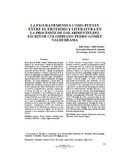Mostrar el registro sencillo del ítem
La figura femenina como puente entre el erotismo y literatura en La procesión de los ardientes del escritor colombiano Pedro Gómez Valderrama
| dc.rights.license | http://creativecommons.org/licenses/by-nc-sa/3.0/ve/ | |
| dc.contributor.author | Peña Arenas, Cindy Mayerly | |
| dc.date.accessioned | 2011-12-13T21:35:32Z | |
| dc.date.available | 2011-12-13T21:35:32Z | |
| dc.date.issued | 2011-12-13T21:35:32Z | |
| dc.identifier.issn | 0798-1570 | es_VE |
| dc.identifier.uri | http://www.saber.ula.ve/handle/123456789/34271 | |
| dc.description.abstract | En la obra de Pedro Gómez Valderrama un gran número de narraciones exploran fenómenos relacionados con el erotismo y su expresión a través del cuerpo femenino, especialmente en “La procesión de los ardientes”, donde se manifi esta en un tono paródico e irónico, la presencia de la música, la mitología, la religión, la historia y pone en escena diferentes creencias, ritos, costumbres y supersticiones de la cultura colombiana -de origen africano- así como ambientes y situaciones de demonismo y brujería. En este artículo se aborda la unión entre literatura y erotismo como encuentro de dos experiencias vitales del hombre; en las que se renueva su signifi cado y permite comprender la fuerza del placer y del goce, y al mismo tiempo el desorden y desestabilización bajo los planteamientos del escritor y antropólogo francés George Bataille en su libro El erotismo (1957) a través del cuento “La procesión de los ardientes” en el cual la prohibición y la condenación del erotismo en la sociedad del siglo XIX y la fi gura femenina comunican a través del cuerpo un ideal universal de libertad, en referencia a una experiencia cercana a la religión. Es así como el erotismo y la sexualidad representan la libertad del ser. | es_VE |
| dc.language.iso | es | es_VE |
| dc.rights | info:eu-repo/semantics/openAccess | |
| dc.subject | Pedro Gómez Valderrama | es_VE |
| dc.subject | Erotismo | es_VE |
| dc.subject | Literatura | es_VE |
| dc.subject | Cuerpo | es_VE |
| dc.subject | Figura femenina | es_VE |
| dc.title | La figura femenina como puente entre el erotismo y literatura en La procesión de los ardientes del escritor colombiano Pedro Gómez Valderrama | es_VE |
| dc.title.alternative | The female figure as a bridge between erotism and literature in Procession of the burning by Colombian writer Pedro Gómez Valderrama | es_VE |
| dc.type | info:eu-repo/semantics/article | |
| dc.description.abstract1 | In Pedro Gómez Valderrama’s work a big number of stories explore the phenomena related to eroticism and its expression through the female body, especially in “La procesión de los ardientes” where it is shown in an ironic mood, the presence of music, mythology, religion, history, and it is put in scene different beliefs, rituals, costumes and superstitions from the colombian culture – african origin – as well as evil and witchcraft environments and situations. In this article joining between the literature and eroticism is analyzed as the meeting of two vital man’s experiences, in which their meaning are redefi ned and let to understand the straight and joyce, and at the same time the disorder and destabilization below French anthropologist and writer George Bataille´s arrangements in his book The eroticism (1957) through the tale «La procesión de los ardientes » in which the prohibition and damnation of eroticism in the XIX century society and the female body communicate through the body a universal ideal about freedom refered to a closed experience to the religion. It is in this way how the eroticism and sexuality represent the freedom from the human being. | es_VE |
| dc.description.colacion | 33-40 | es_VE |
| dc.description.email | maye2601@gmail.com | es_VE |
| dc.identifier.depositolegal | PP92-0047 | es_VE |
| dc.subject.centroinvestigacion | Centro de Investigaciones Literarias y Lingüísticas Mario Briceño Iragorry | es_VE |
| dc.subject.facultad | Núcleo Rafael Rangel (NURR) | es_VE |
| dc.subject.keywords | Eroticism | es_VE |
| dc.subject.keywords | Literature | es_VE |
| dc.subject.keywords | Body | es_VE |
| dc.subject.keywords | Female figure | es_VE |
| dc.subject.publicacionelectronica | Revista Cifra Nueva | es_VE |
| dc.subject.seccion | Revista Cifra Nueva: Artículos | es_VE |
| dc.subject.thematiccategory | Artes y Humanidades | es_VE |
| dc.subject.tipo | Revistas | es_VE |
| dc.type.media | Texto | es_VE |
Ficheros en el ítem
Este ítem aparece en la(s) siguiente(s) colección(ones)
-
Cifra Nueva - Nº 023
Enero - Junio 2011


